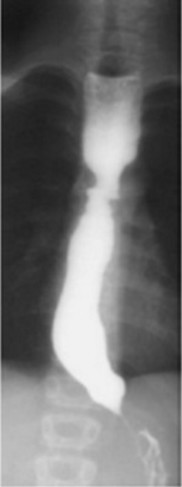(triple A syndrome, 3A syndrome, 4A syndrome)
Prevalence (1/106). Autosomal recessive transmission of a mutation of the AAAS gene (12q13) coding for the ALADIN protein (Alacrima-Achalasia-Adrenal Insufficiency Neurologic Disorder). The name 'triple A'is the acronym in English of Adrenal insufficiency Achalasia of cardia, Alacrima; sometimes Autonomic nervous system dysfunction is added, giving then 4A.
Signs appear progressively, and not simultaneously, which can delay diagnosis.
Quite variable association of:
- achalasia: dysphagia (sometimes of delayed-onset (adolescence, adult age) causing a statural growth delay and some "vomiting" since childhood, frequent episodes of pneumonia or asthma refractory to treatment (following repeated infections or compression of the tracheobronchial tree by the dilated esophagus), of bronchiectasias; sometimes retrosternal pain

- alacrima: dry eyes
- adrenal failure resistant to ACTH: the symptoms usually appear during the first decade: hypoglycemia (convulsions), orthostatic hypotension, hyperpigmentation of the skin and mucous membranes, shock, osteoporosis
- sometimes: pubertal delay
Autonomic dysfunction, axonal neuropathy and intellectual deficiency may be associated.
The criteria of autonomic dysfunction in children are:
- a fall of blood pressure greater than 20 mmHg for the systolic and 10 mmHg for the diastolic pressure for at least 3 minutes when the child stands up from the supine position
- a R - R ratio <1 between the 30th and 15th heartbeat when the child stands up from the supine position.
Neurological problems appear during adulthood: optic atrophy, deafness, peripheral neuropathy of the limbs, neurologic bladder, ataxia, dementia.
In contrast to classic achalasia where there is a gradual disappearance of plexus myenteric nodes (of infectious or autoimmune origin), in achalasia of the Allgrove syndrome, these nodes remain intact but a fibrosis of the intermuscular plan appears due to a deficiency of NO synthase.
Treatments: repeated esophageal dilation, injections of botulinum toxin in the esophageal wall, Heller myotomy associated with an anti-reflux procedure.
Anesthetic implications:
Prevention of acute adrenal insufficiency (first cause of mortality of patients with the disease), risk of hypoglycemia, eye protection. Recurrent respiratory infections. Management of induction as for a "full esophagus": it is mandatory to try to empty the dilated esophagus before induction of anesthesia: cricoid pressure is impractical and potentially dangerous in this context.
References :
- Chaurasiya OS, Kumar L, Nagapoonam MP.
Allgrove syndrome.
Curr Pediatr Res 2010 ; 14 : 89-91.
- Kimber J, McLean BN, Prevett M, Hammans SR.
Allgrove or 4”A” syndrome: an autosomal recessive syndrome causing multisystem neurological disease.
J Neurol Neurosurg Psychiatry 2003; 74: 654-7.
- François N, Chouraqui M, Babre F, Maurette P, Nouette-Gaulain K.
Fibroscopie oeso-gastro-duodénale diagnostique chez l’adolescent : quand penser à l’achalasie du cardia ?
Ann Fr Anesth Réanim 2012 ; 31 : 72-5.
- Li Y, Fallon SC, Helmrath MA, Gilger M, Brandt ML.
Surgical treatment of infantila achalasia : a case report and literature review.
Pediatr Surg Int 2014 ; 30 : 677-9.
- Arun BG, Deepak BS, Chakravarthy MR.
Anaesthetic management of a patient with Allgrove syndrome.
Indian J Anaesth 2014; 58: 736-8.
- Ledoyen A, Bresson V, Deneux I, Reynaud R, Retornaz K, Bosdure E, Dubus J-C.
Une dilatation des bronches révélant un syndrome du triple A.
Arch Fr Pédiatr 2015 ; 22 : 746-9
- Dhar M, Verma N, Singh RB, Pai VK.
Triple A to triple S: from diagnosis to anesthetic management of Allgrove syndrome.
J Clin Anesth 2016; 33: 141-3
- Bentalha A, Zerkouni Y, El Koraichi A, El Kettani SEC.
Syndrome d’Allgrove : un challenge pour l’anesthésiste.
Anesth Réanim 2019 ; 5 :46-8.
- Cehic M, Mitrovic K, Vukovic R, Milenkovic T, Kovacevic G, Todorovic S, Panic Zaric S, Cvetkovic D, Paripovic A, Huebner A, Koehler K, Quitter F.
Very early and severe presentation of Triple A syndrome : case report and review of the literature.
Front Endocrinol 2024 ; 15:1431383. doi: 10.3389/fendo.2024.1431383
Updated: April 2025